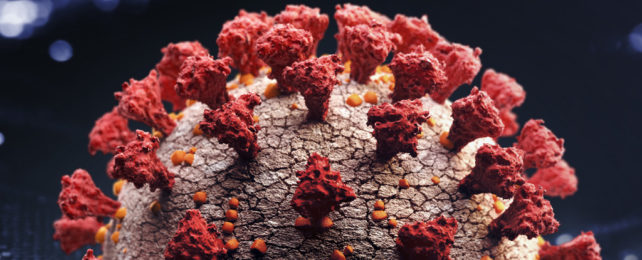Boston University scientists have created a hybrid version of the coronavirus that causes COVID-19.
Their experiments sparked controversy, with heated headlines claiming that the researchers made the virus more lethal and university officials denouncing these claims as "false and inaccurate."
The new Omicron spike-carrying virus – built by attaching the spike protein from an Omicron version of the virus to the original SARS-CoV-2 virus – killed 80 percent of lab mice infected with it, making it more severe than the original Omicron variant which didn't kill any infected mice.
Yet the hybrid virus was still less deadly than the original Wuhan variant of the virus, which killed 100 percent of infected lab mice.
Scientists at Boston University's National Emerging Infectious Diseases Laboratories (NEIDL) created the chimeric virus to study how Omicron versions of the virus, which first appeared in 2021, evade immunity built up against past strains and yet cause a lower rate of severe infections.
After exposing mice either to the chimeric virus or to the naturally-occurring Omicron BA.1 virus, the researchers found that the mutated spike protein of the Omicron virus did enable it to dodge immunity, but that the mutated spike wasn't responsible for making Omicron less severe.
The researchers published their findings October 14 on the preprint database bioRxiv, so it has yet to be peer-reviewed.
Related: 21 of the worst epidemics and pandemics in history
"Consistent with studies published by others, this work shows that it is not the spike protein that drives Omicron pathogenicity, but instead other viral proteins. Determination of those proteins will lead to better diagnostics and disease management strategies," lead author Mohsan Saeed, an assistant professor at NEIDL, said in a statement, according to STAT.
Although the research was conducted properly in a biosecurity level 3 laboratory and approved by an internal biosafety review committee and Boston's Public Health Commission, controversy is swirling around the study because the researchers did not clear the work with the National Institute of Allergy and Infectious Diseases (NIAID), which was one of its funders, STAT reported.
The scientists also didn't divulge to NIAID if their experiments could create an enhanced pathogen of pandemic potential (ePPP), according to STAT.
To be awarded federal funding for research on viruses with pandemic potential, proposals have to pass through a committee process, called a P3CO framework, that assesses the pros and cons of the work.
"What we would have wanted to do is to talk about exactly what they wanted to do in advance, and if it met what the P3CO framework defines as enhanced pathogen of pandemic potential, ePPP, we could have put a package forward for review by the committee that's convened by HHS, the office of the assistant secretary for preparedness and response," Emily Erbelding, director of NIAID's division of microbiology and infectious diseases told STAT.
"That's what the framework lays out and that's what we would have done."
Eberling said that NIAID would have "conversations over upcoming days" with the researchers.
The mistake may have emerged from an ambiguity in the P3CO framework's rules. For a virus to be defined as an ePPP, it has to be reasonably expected to produce pandemic potential results in humans.
The mice used by the researchers for the study, however, might not have seemed to them to be a close enough analogue.
Boston University has pushed back against media reports, most notably an article published by the UK's Daily Mail, which claimed the research had created a more dangerous variant.
"We want to address the false and inaccurate reporting about Boston University COVID-19 research, which appeared today in the Daily Mail," Boston University said in a statement.
"First, this research is not gain-of-function research, meaning it did not amplify the Washington state SARS-CoV-2 virus strain or make it more dangerous. In fact, this research made the virus replicate less dangerous." (The "Washington state SARS-CoV-2 strain" refers to a sample of the original Wuhan strain gathered in Washington in the early pandemic.)
Ronald B. Corley, the director of NEIDL, said in the statement that the Daily Mail report "sensationalized the message" and misrepresented "the study and its goals in its entirety."
"The animal model that was used was a particular type of mouse that is highly susceptible, and 80 to 100 percent of the infected mice succumb to disease from the original strain, the so-called Washington strain," Corley said. "Whereas Omicron causes a very mild disease in these animals."
Related content:
- 11 (sometimes) deadly diseases that hopped across species
- 14 coronavirus myths busted by science
- The deadliest viruses in history
This article was originally published by Live Science. Read the original article here.
